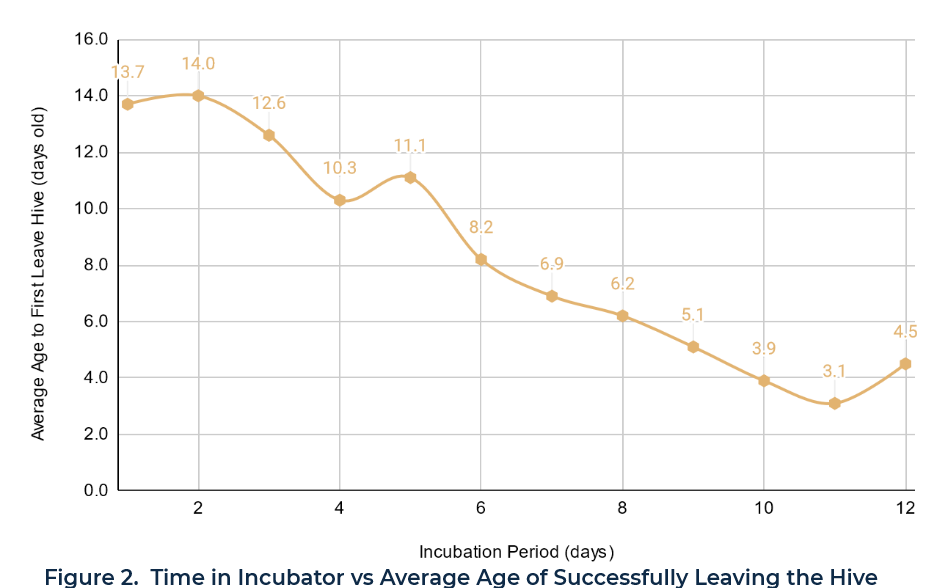Remote Sensing of Honey Bees
From Living Building Science
Contents
Abstract
During winter, bees sometimes starve to death due to insufficient supply of honey or from the phenological mismatches between when the bees emerge & the availability of floral resources. To counter this issue, urban beekeepers provide their bees with sugar substitutes, but these substitutes lack the necessary enzymes & nutrients found in their natural food supply. We explored possible solutions to maximize foraging behaviors & ultimately increase the natural food supply of urban honeybees, which can potentially increase pollination & the viability of surrounding biodiversity.
Due to limited time & resources, our experiment will begin in Spring 2022. Since we only have access to one incubator, we plan to set the incubation temperature at 32.5°C. We also plan on recording the age, duration of incubation, & movement in & out of the hive using the RFID system. To monitor the hive temperature, we will be using BroodMinder to log & store live hive temperature & humidity data via Bluetooth.
Remote Sensing of Honey Bees
Introduction to the System of Study
There are currently over 500 species of bees found in Georgia. One of the most abundant is the Apis mellifera, commonly known as the western or European honey bee (Schlueter, 2020). Like other Hymenopterans, their unfertilized eggs develop into males & their fertilized eggs develop into females. The female larvae that are fed pollen, nectar, & brood become workers. Worker bees are non-reproductive female bees that make up a majority of a hive. As their name suggests, workers specialize in a variety of tasks including, but not limited to, tending to the queen, nursing young, & foraging. Foragers specialize in traveling to floral sites & returning to the hive with nectar & pollen (Dargahi & Todd, 2020). An experiment conducted in 2016 found a correlation between incubation temperatures of brood and adult behaviors and specialization within the hive. They found that adult bees that were incubated at 35°C and 36°C performed better in terms of behavior, learning, and memory compared to those raised at 32°C. They also noted that foragers incubated at 32°C would begin foraging at 2 weeks, similar to those incubated at 35°C and 36°C. However, they noticed that more bees in the 32°C group would leave the hive at normal foraging times but would not return to the hive (Wang, Xu, Zhu, Chen, S. Zhou, Huang, & B. Zhou, 2016).
Methodology
RFID Tags
RFID tags are a type of tracking system that uses smart barcodes in order to identify items. RFID stands for “radio frequency identification,” and as such, RFID tags utilize radio frequency technology. These radio waves transmit data from the tag to a reader, which then transmits the information to an RFID computer program. RFID tags are frequently used for merchandise, but they can also be used to track vehicles, pets, etc.
Type of Bee
The type of bees that we worked with is called worker bees which are non-reproductive female bees that make up a majority of a hive. As their name suggests, workers specialize in a variety of tasks including, but not limited to, tending to the queen, nursing young, & foraging (Dargahi & Todd, 2020).
Tagging Methods
A small amount of store-bought super glue is applied to the RFID sensor and, while holding the bee lightly with a pair of forceps at the upper abdomen (holding down the wings), the RFID tag is placed between the wings at the top of the thorax. The bee is released after a few seconds. In some cases, bees are collected and held manually during the RFID fitting or several bees are brought to the laboratory where placing the bees in the freezer for a short amount of time can be used to decrease bee movement as the bees fall asleep. It will be ideal to tag bees as they hatch in their first day of life as an adult due to their inability to fly. Tagged bees were then placed in hive in Kendeda Building.
Prospective Results
We tracked 442 temperature points over 19 days, taken from the mid-upper hive where winter clustering occurs. While widely variable, the average internal hive temperature was 25.7°C, which is highly unfavorable for successful incubation.

This indicates proceeding with incubating at elevated temperatures, even at a “low” 32.5°C, should be beneficial for the hives of Kendeda.

As this study expands to gather data on remaining incubation temperatures, we should see an increase of successful flight returns, while still taking into account typical climate events in Atlanta, Georgia & predation. This again would be accredited to better self-control of bees incubated at higher temperatures (3, 6).
Conclusion
While we were unable to begin the true experiment this semester due to seasonal changes & resource availability, we proposed a robust experimental design plan that can be used for at least the next two to six semesters. Based on prior literature, it increasing the incubation temperature of honeybees results in more engaged & efficient flight behavior while minimizing mortality rates (2, 5, 6). Thus, we expect to see successful first flights occurring at younger ages for those incubated for longer periods across the board for 32.5°C, 34.5°C, & 36°C. With this, we would also anticipate seeing fewer losses of bees after they leave the hive for their flights, with the least amount of loss among incubations of 36°C.
Limitations of this include only having one incubator, which prolongs this experiment’s time. Additionally, we do not have the resources to distinguish orientation flights or subsequent orientation flights from foraging flights; thus, we only focus on first flights.
Photos
Please view our semester photo gallery here!
Team Members
| Name | Major |
|---|---|
| Zoë Altizer | Biology |
| Zoe Kim | Biology |
| Sarah Talwar | Neuroscience |
